The Ideal Smile
Almost anyone can have the ideal smile they dream about. But there is a great deal more to the perfect ideal smile than white teeth. Most people who look at a smile will look at the colour and the alignment of the top and bottom teeth and notice whether teeth are crooked.
A filling or a crown that doesn't match natural tooth structure may also be noticed. But the teeth are only one of three equally important components of a ideal smile. The human mouth is a stage which is framed by the lips and the soft tissue that surround the teeth. If either of these deviates from the accepted norm, even if the teeth are straight and white, the smile may appear unsightly.
Your lips frame your gums and teeth. There is not much a Cosmetic dentist can do about the muscles and attachments of the lips. But the lips have a dominant role in your ideal smile. The lip-line is divided into three types; low, medium and high. A low lip-line means you show little or no tooth structure when you talk or smile.This is usually regarded as being the appearance of an older person, and definitely not the facial profile of the ideal smile .


Smile Creation - Facial & Dental Aesthetics
Cosmetic dentist, Dr. Kaviani explains that ,The skin and muscles of the human face drop about 1 mm every 10 years, beginning at about age 40. This is due to gravity and a loss of tissue elasticity. As the muscles and skin drop, less tooth structure is seen, which contributes to an older appearance of a low lip-line. The older you are, less of the top teeth will be visible and more of the bottom teeth will be visible. A medium lip-line is one where the whole tooth shows when talking or smiling.
The line of the teeth generally follows the lower and upper lip-lines. This appearance, coupled with dominant front teeth, is considered as being the most desirable type of smile. A high lip-line is one where all of the front teeth and gum tissue above the top front teeth are visible. It can range from a little gum to a large amount of gum tissue visible. This is considered a less pleasing appearance.
The gum tissue surrounds the teeth. These tissues should fill in the space between teeth, so that all you see is gums and teeth -- no spaces. Where the teeth appear to come out of the gum, the gum should have a scalloped look. The gum should be situated higher on the central incisors , lower on the lateral incisors.
Dr. Kaviani believes that correct appearance is of primary importance in developing an ideal smile profile in a smile makeover process. If the height of the gum is too low or too high around a specific tooth or several teeth, even if the teeth are straight, they will look "wrong."
The teeth should generally follow the lip-line from left to right and should be proportionate to each other. Most often, a length to width ratio of 1.6:1 is desirable. Adjacent teeth also follow a similar proportional ratio when viewed straight on. If individual teeth are too long, wide, not in proportion to each other or not mirror images left to right, aesthetic problems result.
Prominent cosmetic dentist in Preston ; Dr.H. Kaviani can easily recognise these problems and offer suggestions for improved aesthetics. You may not know what is wrong with your teeth, but you know that you do not have the ideal smile you want. It may not be the teeth alone. The framing of the teeth by your lips and the architecture and position of the gums surrounding your teeth are two variables in a three-part equation for the ideal smile -yours !
We have the technology for you to visually see what is possible to design and improve your smile. For more information on your Ideal Smile Design , please contact our patient care coordinator; Yvonne on 01772-726932 to arrange your Smile Makeover consultation
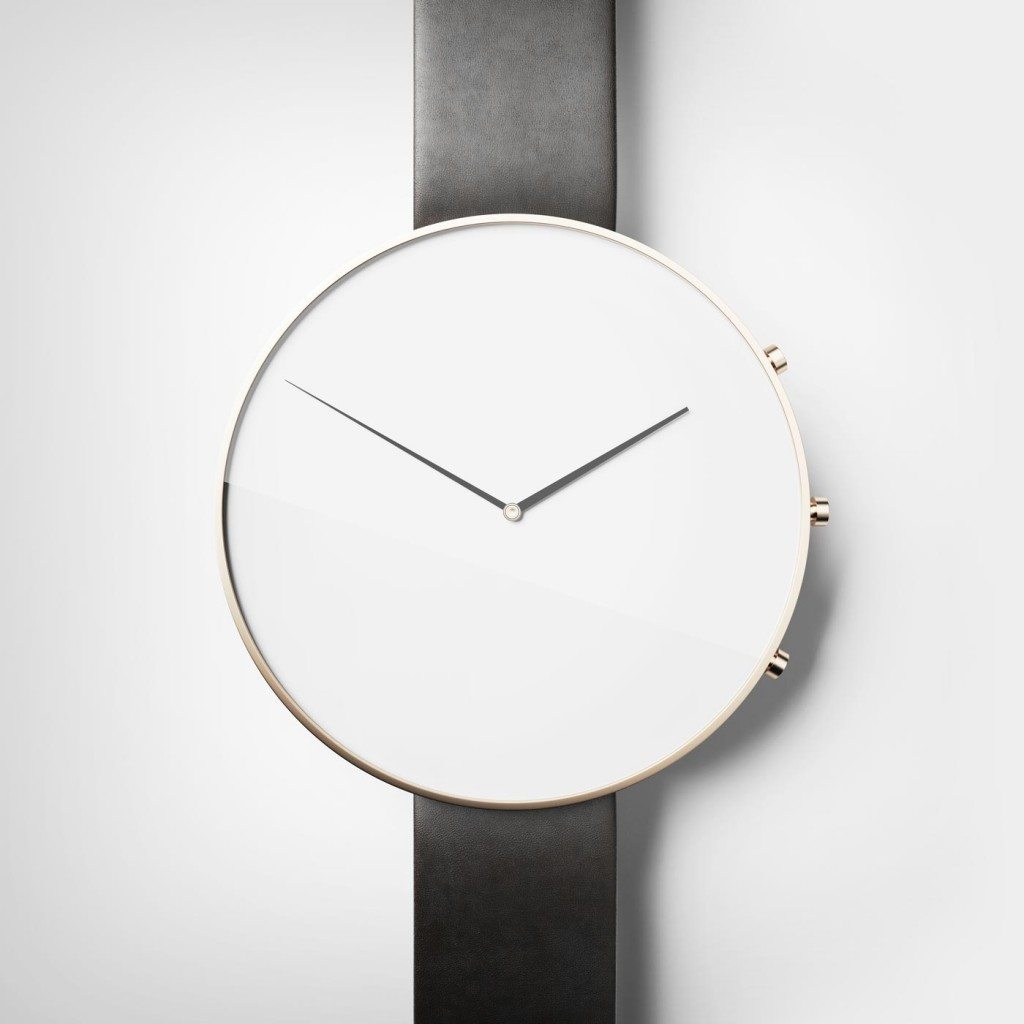
The Art of Designing The Perfect Smile
Ideal Smile Design Rules
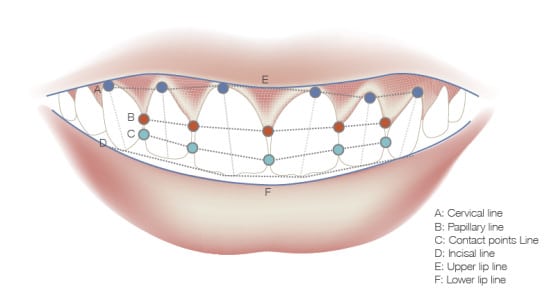 Your smile line is the line created by the top of your lower lip. In an ideal smile line, the edges of your upper teeth should be parallel to your lower lip when you smile. The bottom of your lower lip should have the same line as the gums of your lower jaw.
Your smile line is the line created by the top of your lower lip. In an ideal smile line, the edges of your upper teeth should be parallel to your lower lip when you smile. The bottom of your lower lip should have the same line as the gums of your lower jaw.
This should always be a standard, regardless of the size or shape of your smile. Once we have determined the orientation of your smile line, he or she can design its curve, or shape, and determine the length of your new restorations.
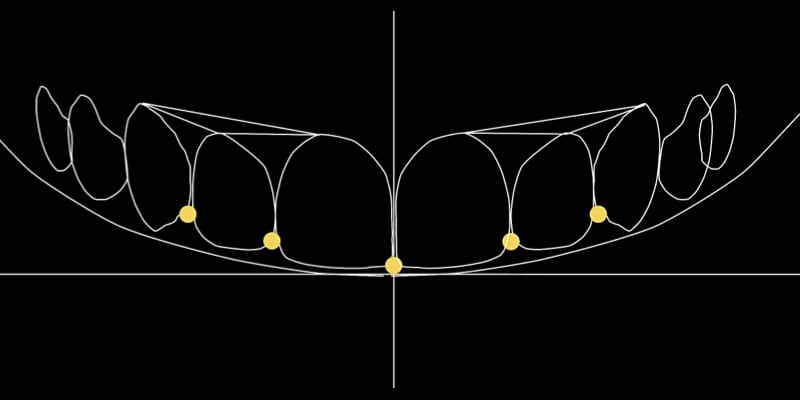 The teeth towards the back of the mouth can always be seen in an attractive smile. In a narrow smile the back teeth are often in shadow (this is called negative space), thus creating the appearance of shadows at the corners of the mouth and front teeth that appear to stand out.
The teeth towards the back of the mouth can always be seen in an attractive smile. In a narrow smile the back teeth are often in shadow (this is called negative space), thus creating the appearance of shadows at the corners of the mouth and front teeth that appear to stand out.
The incisal edge position – how far down/long the top two middle teeth are – sets the stage for the proportions of the rest of your smile and smile line. Apart from serving an important aesthetic function, this position is vital to proper function, in addition to speech and making sounds that start with “F” and “V”, for example.
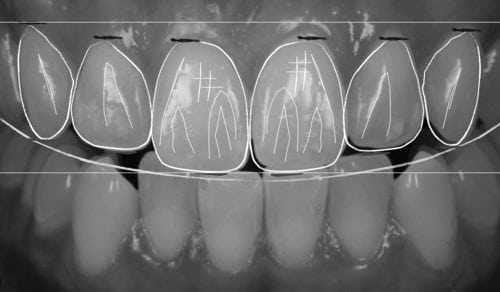 For the perfect ideal smile , the colour of each tooth should be even and should match every tooth in the smile. At the beginning of designing your new smile, we carefully plan with you which shade of white you would like your new smile to be. There are many shades of white, and each person has their own idea of the shade that they would like to be.
For the perfect ideal smile , the colour of each tooth should be even and should match every tooth in the smile. At the beginning of designing your new smile, we carefully plan with you which shade of white you would like your new smile to be. There are many shades of white, and each person has their own idea of the shade that they would like to be.
Natural enamel can be whitened with professional teeth whitening, and dental restorations can be made in every shade of white to match the adjacent teeth, however once dental restorations are made, their colour is fixed.
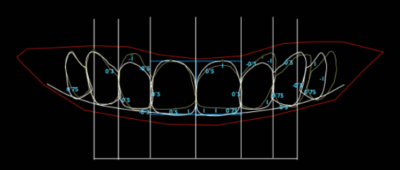 Symmetry is the key to smile design, and we look at the symmetry of the teeth, gums, and lips in relation to your whole face. The starting point of any smile design is the facial midline, an imaginary vertical line drawn between the front two upper teeth. For optimal aesthetic value, the facial midline should be in the middle of the face.
Symmetry is the key to smile design, and we look at the symmetry of the teeth, gums, and lips in relation to your whole face. The starting point of any smile design is the facial midline, an imaginary vertical line drawn between the front two upper teeth. For optimal aesthetic value, the facial midline should be in the middle of the face.
Prominent facial features – such as the eyes, nose and chin – can be misleading when locating the midline. For instance, your eyes may be at slightly different levels, or your nose may be off-centre, lessening their usefulness when trying to find the midline.
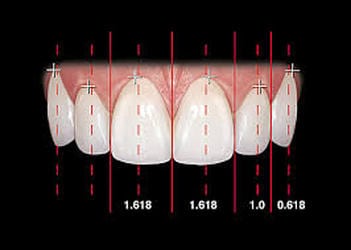 Most people perceive a pleasing smile as one in which the two central front teeth are dominant and have a width-to-length ratio of 75 to 80 percent. This proportion guides the length and width of other teeth in the aesthetic zone (the section of upper and lower teeth that show when you smile), making your smile appear balanced or symmetrical.
Most people perceive a pleasing smile as one in which the two central front teeth are dominant and have a width-to-length ratio of 75 to 80 percent. This proportion guides the length and width of other teeth in the aesthetic zone (the section of upper and lower teeth that show when you smile), making your smile appear balanced or symmetrical.
Long teeth equate to a younger-looking smile. Over the years, normal wear and tear has a shortening or ageing effect on your teeth and overall appearance. Teeth length also may play a role in facial contouring. For instance, long, square-shaped teeth on a plump, round face creates a slimming effect.
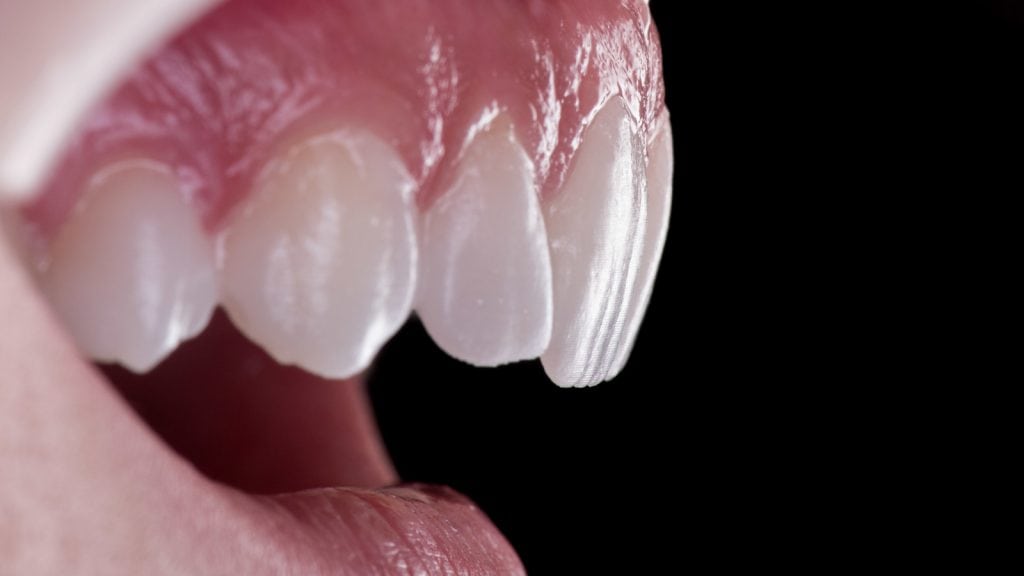 Gum tissue should look healthy (meaning, no red, puffy or bleeding gums). Gingival contour is the shape or form of the gums around the necks of the teeth. The “ideal” smile should not show more than three millimetres of gums between the top of your tooth and the bottom of your upper lip.
Gum tissue should look healthy (meaning, no red, puffy or bleeding gums). Gingival contour is the shape or form of the gums around the necks of the teeth. The “ideal” smile should not show more than three millimetres of gums between the top of your tooth and the bottom of your upper lip.
The shape of the gums of the lower incisors and the upper laterals should be a symmetrical half-oval or half-circular shape. The upper centrals and canines should show a more oval, or elliptical, shape to the gums.
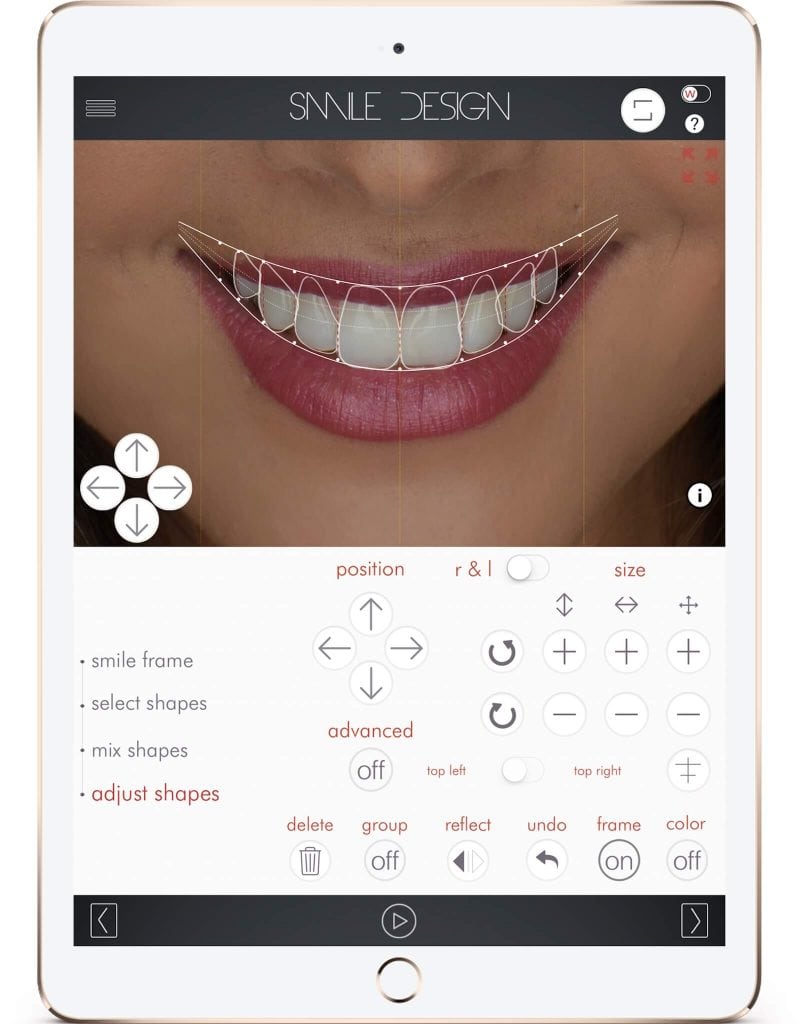 The lips have been compared to a frame that sets off the image of your smile, encompassing your teeth and gums. Enhancing or correcting the shape, fullness and symmetry of your lips can make your smile seem fuller.
The lips have been compared to a frame that sets off the image of your smile, encompassing your teeth and gums. Enhancing or correcting the shape, fullness and symmetry of your lips can make your smile seem fuller.
For the ideal smile creation, your facial features should line up to your teeth and lip lines. When your lips form a broad smile, an imaginary line can be drawn through the corners of the mouth, from one side to the other.
The amount of upper front (maxillary anterior) tooth revealed below this line helps create a vibrant, youthful image. In a youthful smile, the upper front teeth should fill between 75 to 100 percent of the space between your upper and lower lips in a full smile.
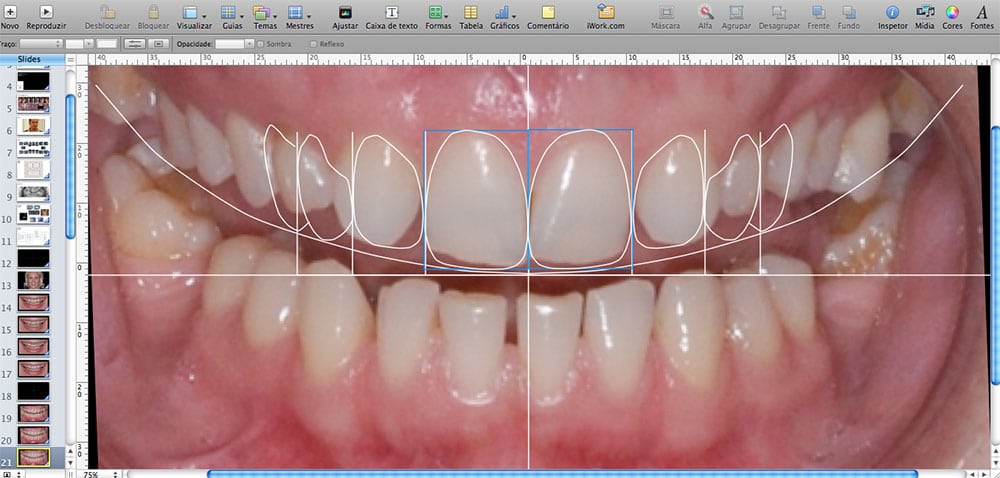 The buccal corridor is the dark space visible between the corners of the mouth and the upper teeth. Research indicates that, under most circumstances, individuals with considerably smaller buccal corridors (broader smiles) are thought to have the “best” or “most attractive” smiles.
The buccal corridor is the dark space visible between the corners of the mouth and the upper teeth. Research indicates that, under most circumstances, individuals with considerably smaller buccal corridors (broader smiles) are thought to have the “best” or “most attractive” smiles.
Women, in general, have significantly broader smiles, increased tooth arcs and reduced tooth/lip arc differences than men.
